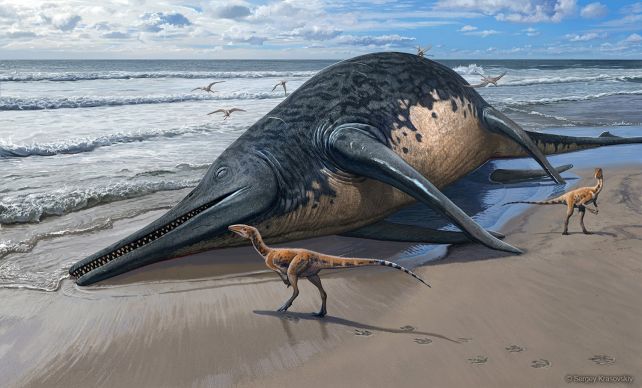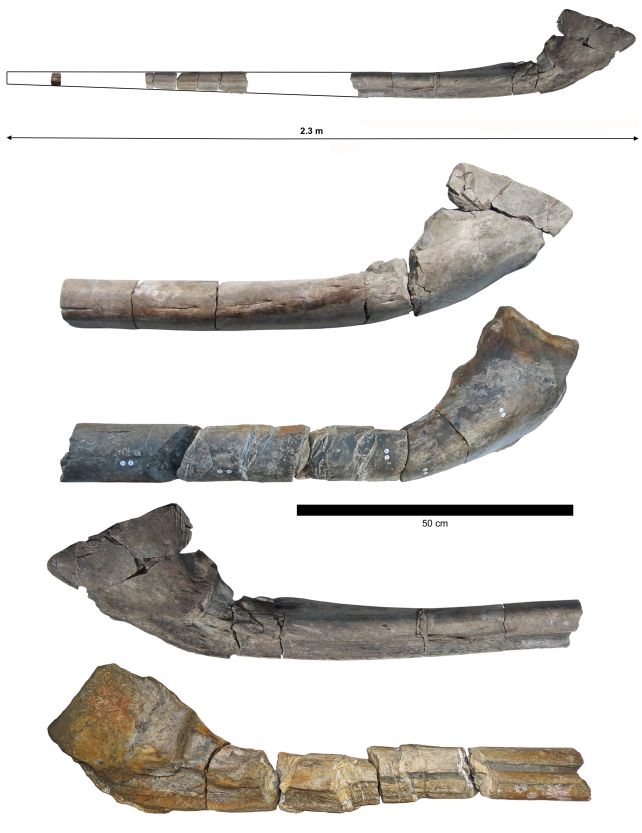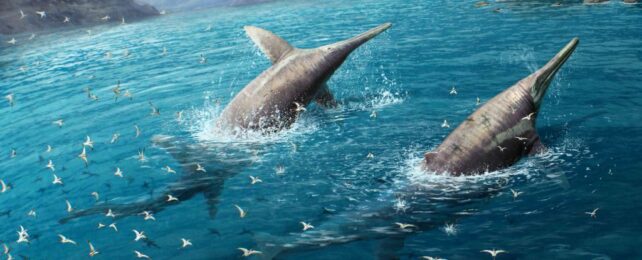Fragments of bone discovered buried in ancient rock hint at a truly colossal Leviathan that once terrorized the waves.
Researchers from the UK and US argue the fossilized remnants of two separate jawbones found England's south west represent a previously unknown genus of late Triassic ichthyosaur that seems to vastly outstrip in size any other known marine reptile that has lived on this planet.
Bestowing the name Ichthyotitan severnensis on the new genus and species, the team estimates the animal would have had a length of up to more than 25 meters (82 feet, or twice as long a standard bus) – a true sight to behold even today, coming close to the 30 meters of a blue whale.
"I was amazed by the find," says paleontologist Dean Lomax of The University of Manchester in the UK.
"In 2018, my team (including Paul de la Salle) studied and described Paul's giant [ichthyosaur] jawbone and we had hoped that one day another would come to light. This new specimen is more complete, better preserved, and shows that we now have two of these giant bones – called a surangular – that have a unique shape and structure. I became very excited, to say the least."

The first fossilized segment of bone was discovered by de la Salle in 2016 on the coast of Lilstock in Somerset, England, and scientists knew pretty quickly that they were onto something interesting. Although just a rear portion of jawbone known as the surangular, its size indicated it came from an ichthyosaur larger than any other known. In the absence of other evidence, though, it was difficult to learn more about the beast nicknamed the Lilstock Monster.
A breakthrough came in 2020. A man named Justin Reynolds and his daughter Ruby, then aged 11, were searching for fossils on a beach at Blue Anchor in Somerset when Ruby happened across the first piece of another jawbone. They contacted Lomax, who contacted de la Salle, and the hunt was on.
The last piece of the bone was collected in October 2022, and the paleontologists got to work putting the puzzle together and identifying the creature to which the jaw belonged. And they found that the new surangular had the same unique features seen in the jawbone of the Lilstock Monster.
Both bones are similar in size and morphology, as well as time and location of discovery, both found along the Somerset coast in mudstone deposits dating to the late Triassic. However, the more recently discovered fragment was more complete and in much better condition, allowing the scientists to learn more about this enigmatic beast.
Ichthyosaurs first emerged onto the scene about 250 million years ago, growing to lengths of over 15 meters. However, the giants didn't emerge until the Late Triassic, and paleontologists believe that they didn't last long, getting wiped out in the Triassic-Jurassic extinction 200 million years ago.

This might explain the scarcity of giant ichthyosaur bones in the fossil record, although fragments have been found hinting at some chonkers clocking in at over 20 meters. Ichthyotitan, emerging some 13 million years later than their giant relatives, outstrips even those creatures.
And there's evidence to suggest that the two individuals – whose bones are finally revealing the animals to us hundreds of millions of years later – hadn't reached their full size when they died.
"We could confirm the unique set of histological characters typical of giant ichthyosaur lower jaws: the anomalous periosteal growth of these bones hints at yet to be understood bone developmental strategies, now lost in the deep time, that likely allowed late Triassic ichthyosaurs to reach the known biological limits of vertebrates in terms of size," says paleontologist Marcello Perillo of the University of Bonn in Germany.
"So much about these giants is still shrouded by mystery, but one fossil at a time we will be able to unravel their secret."
The team's discovery has been published in PLOS ONE.
